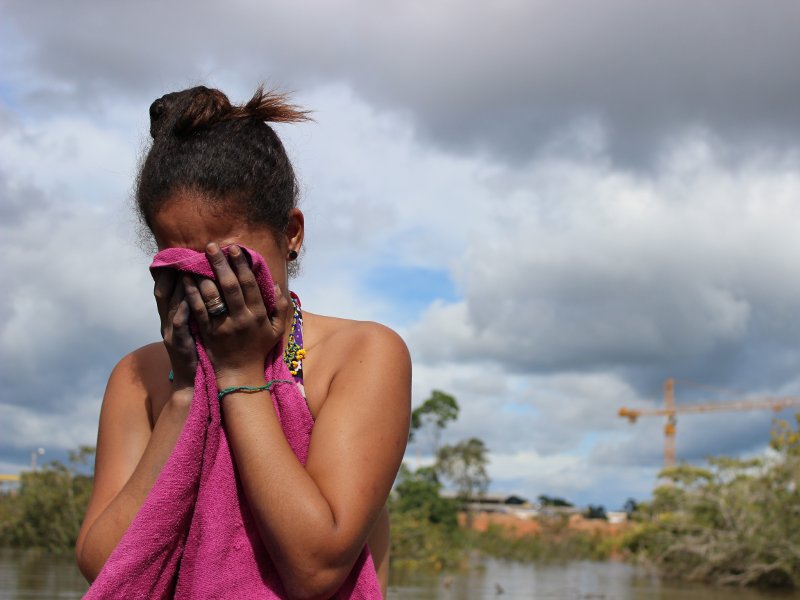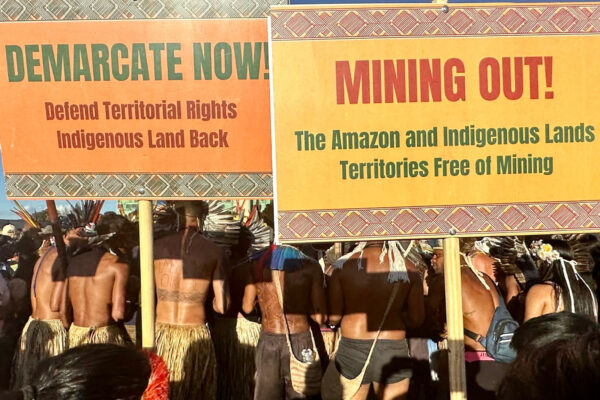
The Brazilian government is building the world’s third largest hydroelectric dam on one of the Amazon’s major tributaries, the Xingu River. The Belo Monte dam would divert the Xingu and devastate a large part of the Brazilian rainforest, displacing at least 20,000 people (some estimates suggest up to 40,000). Many had hoped that the dam would mean prosperity and a better life; but the way the dam’s construction company, Norte Energia, has gone about the resettlement of the displaced families has been the subject of a formal complaint by the Brazilian public prosecutor’s department – among several legal actions relating to Belo Monte taken by the public prosecutor.
Since the construction of the Belo Monte dam began, the city of Altamira has been in a state of “complete chaos in all social and public policy areas, especially health, public safety, and housing,” says Antonia Melo, leader of the movement Xingu Alive Forever. “There has been rampant population growth as well as rises in drug abuse and child prostitution, among other forms of violence.”
Melo (as we like to call her) has campaigned tirelessly against the dam since it was first proposed and was subsequently stopped following the historic Altamira gathering of 1989 and a global campaign that called for the cancellation of World Bank financing. For more than two decades, she has been a leader in the women’s movement in Altamira, working with churches, schools, indigenous communities and international NGOs to stop the construction of Belo Monte. Her work has been particularly critical in the past five years, ever since the Lula administration intensified efforts to push the project through as part of a massive programme of expansion of large dams across the Amazon by 2030.
The first time Norte Energia presented its project for urban resettlement, it set out plans for three types of houses built with bricks, with two to four bedrooms, and decent infrastructure including water, electricity, sewage systems, schools, recreation areas and health centers. These models were approved by the population. Meanwhile, the terms of the resettlement as laid down by the federal government regulator, IBAMA, included the requirement that resettlement would take place within 2km of the original place of residence.
In 2012, however, according to the public prosecutor, Norte Energia reneged on this commitment and announced they would be building 3 bedroom houses, smaller than previously planned and built from concrete with a standard design; these houses have been described as being “more like little prisons” by Melo. There are further allegations from the public prosecutor that the sites do not have the promised infrastructure, and are significantly further away from the original place of habitation. The plans were confirmed without proper consultation: the meetings organised by Norte Energia with the objective of presenting the resettlement did not allow debate or dialogue on the model of accommodation offered, but consisted, in reality, of a mere presentation of the option that had already been decided upon by the company. That runs counter to the requirements of IBAMA. Despite opposition from residents, Norte Energia went ahead and started to build the houses. Even before people could move into them, the walls reportedly began to crack as a result of dampness. According to Melo, Norte Energia covered the cracks with new paint, but no proper repairs were carried out. As Melo points out, “it’s an extremely humiliating situation that has been turned people’s hopes of a better life into a nightmare.”
Melo believes that this particular series of failures is symptomatic of a wider problem with the manner in which the project is being undertaken, and it is having a profound effect on the local population: ‘People come to my office every day with high blood pressure, depression and other diseases,’ says Melo, ‘and I know it is due to the fact that they fear for their future, and for the future of their children. I hear every day endless complaints about their dissatisfaction with the new houses, and uncertainty of life. I used to advise them to seek judicial means, but I have seen many sitting around for over four years on a lawsuit with no positive response. Now I question myself about our judicial system and what justice it is here to serve.’
Melo is also affected by the Belo Monte dam. Her house will be in a flooded area, and along with the other 20-40,000 people, she will be forced to move. But she will not give up: “The Brazilian federal government and its companies do not respect the laws, nor do they respect social, environmental, and human rights. Our so-called ‘democracy’ looks more like dictatorship and repression. But none of it will make me stop fighting for what is true justice.”













